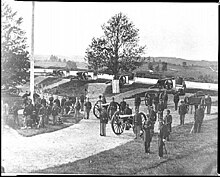Battle of Fort Stevens
| Battle of Fort Stevens | |||||||
|---|---|---|---|---|---|---|---|
| Part of the American Civil War | |||||||
 Officers and men of Company F, 3rd Massachusetts Heavy Artillery, in Fort Stevens. |
|||||||
|
|||||||
| Belligerents | |||||||
|
|
|
||||||
| Commanders and leaders | |||||||
|
Alexander McD. McCook Horatio G. Wright Abraham Lincoln (observer) |
Jubal A. Early | ||||||
| Strength | |||||||
| 9,600 | 10,000 | ||||||
| Casualties and losses | |||||||
| 373 | 400–500 | ||||||
|
|
|||||||
The Battle of Fort Stevens was an American Civil War battle fought July 11–12, 1864, in Northwest Washington, D.C., as part of the Valley Campaigns of 1864 between forces under Confederate Lieutenant General Jubal A. Early and Union Major General Alexander McDowell McCook. Although Early caused consternation in the Union government, reinforcements under Maj. Gen. Horatio G. Wright and the strong defenses of Fort Stevens minimized the military threat and Early withdrew after two days of skirmishing without attempting any serious assaults. The battle is noted for the personal presence of President Abraham Lincoln observing the fighting.
In June 1864, Gen. Jubal Early was dispatched by Gen. Robert E. Lee with the Second Corps of the Army of Northern Virginia from the Confederate lines around Richmond with orders to clear the Shenandoah Valley of Federals and then if practical, invade Maryland, disrupt the Baltimore and Ohio Railroad and if possible threaten Washington, D.C. The hope was that a movement into Maryland would force Union Lt. Gen. Ulysses S. Grant to send troops to defend Washington against the threat, thus reducing his strength to take the Confederate capital of Richmond, Virginia.
...
Wikipedia



